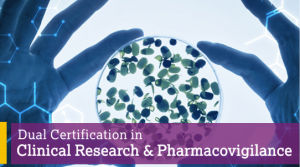Pune, Maharashtra Feb 2, 2020 (Issuewire.com) - Purpose of Pharmacovigilance in Drug Development
Pharmacovigilance is the science and activities relating to the detection, assessment, understanding and prevention of adverse effects of drugs. Moreover, this field of study is covered in clinical research courses to train professionals to heal patients. The goals of Pharmacovigilance are to augment patient care and patient safety in relation to the use of medicines. Furthermore; it aims towards supporting public health programmers by providing reliable, balanced information to determine whether the benefits outweigh the risks of the experimental drugs. Therefore, clinical research institutes make it a point to include all aspects of pharmacovigilance in clinical research courses
Role of Pharmacovigilence in the Drug Development Process
Since pharmacovigilance deals with the detection and prevention of adverse effects, the field of pharmacovigilance is an iterative process focusing on detection of unidentified safety, issues, identification of risk and preventing patients from being affected adversely. Therefore, pharmacovigilance plays a critical role at various stages of drug discovery and their development process. For instance, pharmacovigilance requires submission of various reports on adverse effects experienced during clinical trials to regulatory authorities on a timely basis. In addition to this, the evaluations of benefit and risk of these drugs are also needed to be submitted to authorities.Therefore, pharmacovigilance practices need to be enhanced to assess the drug safety issues during the drug development and the post-marketing surveillance so that patients can be provided with safe and effective innovative medicines so that they can be healed of their illnesses.
https://www.technobridge.in/clinical-research-course.html
Methods of Pharmacovigilance
The field of pharmcovigilance includes three different methods to monitor the safety of all medicines they are:
- Targeted Spontaneous Reporting
The aim of this method is to gain an understanding about the adverse drug reaction of a specific medicine in a population or to estimate the occurrence of a known adverse drug reaction to a specific medicine in a population.
- Cohort Event Monitoring
This method comprises gathering information on the safety of a new drug in the early post-marketing phase. In addition to that, cohort event monitoring is implemented when there are instances of medicines that have caused problems or there are significant adverse drug reactions that are caused during pre or post-marketing surveillance.
- Individual case safety reports
These reports are those documents providing the most complete information related to an individual case at a certain point of time to regulatory authorities. They communicate genuine concerns about real-life suspected adverse drug reactions. These case studies are essential for reporting the unexpected adverse effects or side effects that can take place in patients.
- Clinical Review of case reports
This method includes a review of individual cases of adverse drug reactions reported by healthcare professionals. These reports are published in pharmacovigilace systems for clinical reviews by experts
To conclude, the clinical research industry requires a huge amount of trained clinical research professionals to carry out extensive research. Therefore, it is necessary for professionals to enroll in clinical research courses to gain a total understanding of the field.
Media Contact
technobridge mayabridgetech@gmail.com http://technobridgetech.in









